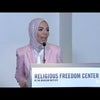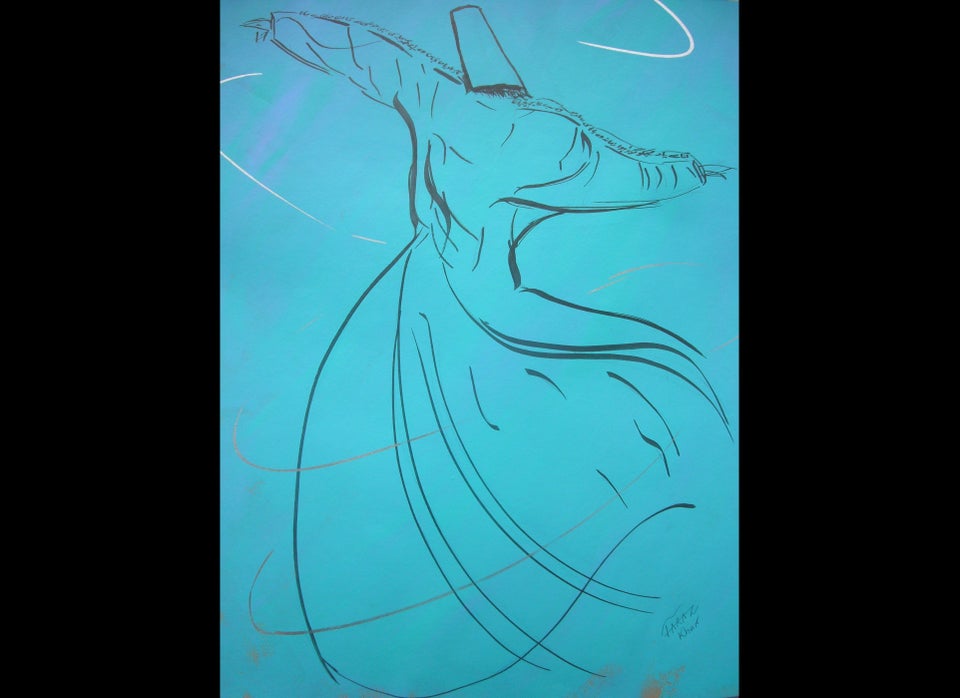
I love art, in so many of its variant forms. Of course, I am hardly alone.
A number of American Muslims pursue their passion for art more actively, however, transforming their affinity into a vocation. Far from passive observers, they are artists whose works speak distinct messages -- some of spiritual intimacy, others of empowerment, education and dialogue and all embody the intersection of the American and Muslim cultural identity.
An artist living in Sacramento, Calif., Janet Kozak Aly, 31, first discovered painting as a child -- she never let go. Many years later, Aly's spiritual conversion to Islam left that relationship undisturbed.
"I started incorporating Islamic themes into my artwork after my conversion in 2000," explains Aly, whose work has culminated in a series of exhibitions. "I generally do not use detailed figures, like humans or animals, in my work, though I may occasionally use silhouettes. I prefer to instead use arabesques and geometric designs."
Aly began incorporating these traditional designs upon traveling to the United Arab Emirates and Egypt where she studied Islamic art. In modifying her artistic choices, she believes her paintings represent a more meaningful spiritual connection.
"I find the abstract nature of mathematical and floral designs more readily explain the organic connection I have to God," reflects Aly.
* * *
Faraz Khan, 36, is a visual artist from Princeton, New Jersey who creates Islamic art and calligraphy with a contemporary touch combining ink and acrylics.
"My work incorporates Arabic calligraphy with modern colorful themes and explores religious and secular themes," explains Khan.
A native of Pakistan, Khan first discovered his fascination with art during a trip to Syria where he immersed himself in the country's history, culture and language. In 2009, he formally began his professional art career.
"I have always been searching for ways to inspire and be inspired by work of faith. Art enables me to leave behind a trail of my struggle to create something meaningful even after I am gone," says Khan of his chosen career path.
And he has excelled.
Khan recently conducted an art class at Princeton University. It concluded with a collaborative group project: a mural transliterating into Arabic calligraphy more than 200 names of the college's streets, buildings, famous graduates and halls. The mural, which includes the names of Princeton alumnae Woodrow Wilson and John F. Kennedy, now hangs on campus.
Further, a commissioned piece for the Witherspoon Institute incorporated Arabic calligraphy in quoting a verse from the Quran: "There is no compulsion in religion, truth has been made manifest over falsehood."
"The artwork, based on the Quranic verse, employed a unique style of Arabic calligraphy to adorn a book cover and website about Islam and religious freedom sponsored by the Witherspoon Institute," touts Khan. "The book will be published in 15 different world languages to celebrate religious pluralism as defined in Islam."
Khan's art "No Compulsion" was first showcased this past summer at a week-long seminar held at the Princeton Theological Seminary. It was a significant moment for him.
"Through my art, I had the opportunity to highlight for a universal audience that religion should be a positive energy that creates beauty and order, not chaos and coercion," says Khan. "And the verse from the Quran captured that high ideal of religious freedom as guaranteed in the American Constitution."
* * *
While some Muslims avoid detailed figures in their work, others hold a different view. Yet, despite these differences, both view their art as an expression of spirituality and an opportunity to share humanity. Haydar Hatemi, 67, is an Iranian-born artist who falls into this latter group.
Notably he has served as the painter for the royal family in Qatar for the past 15 years. He now lives in Lexington, Ky., and paints watercolors and large scale oil paintings.
"I paint various subjects, mainly historical paintings related to Ottoman Empire on different mediums: canvas, wood, paper..." explains Hatemi.
Trained at a fine arts high school and the University of Fine Arts in Tehran, Iran, his inspiration derives from Islamic history generally and the Turkish city of Istanbul, in particular.
"I have two traveling exhibitions, 'City of Sultans: Istanbul' and 'Stories of the Messengers,'" describes Hatemi.
While the "City of Sultans" was designed as a general introduction to the Ottoman dynasty, "Stories of the Messengers" is an interfaith art exhibition.
"'Stories of the Messengers' is based on common stories from the Quran, Bible and Torah," elaborates Hatemi. "It consists of 27 large masterpieces in classical Persian miniature style, each depicting a different prophetic story."
The exhibit includes Hatemi's depictions of Jesus with the Virgin Mary, the story of Moses and Noah and his Ark. Hatemi describes the interfaith community's response as resoundingly positive.
"When people saw the 'Stories of the Messengers' exhibit, Christians came to me and stated that they never knew that Islam recognized and deeply respected Jesus," recalls Hatemi. "They never realized this fact until they came to my exhibition."
* * *
Mona Abdala, 33, is an elementary school teacher by profession, and a painter and photographer by passion.
"I have been drawing since before I can remember, and took an interest in photography and darkroom processing in high school," reflects Abdala. "These days, I teach, lecture, and explore new themes in my work such as motherhood and family."
In fact, Abdala is working on introducing a new art curriculum at the private Islamic school based in central Jersey where she is employed.
"I want to encourage other Muslims to find their passion, and empower them to achieve peace and fulfillment by expressing oneself - one's feelings and unique experiences - through art," explains Abdala. "I feel that it is necessary for Muslims to add to the rich texture of the American arts in all forms."
For Abdala, like those featured above, her work is not about gaining recognition or even financial success. Rather, what she finds most rewarding is her ability to positively impact those around her -- particularly children.
"When after taking classes with me, parents tell me that their child found their passion through art, and boosted his or her self esteem by it, or finally looks forward to coming to school ... that is by far more rewarding than all the fame that could come from being an acclaimed artist," reveals Abdala. "To use this gift to improve a child's demeanor about learning can drastically change the trajectory of a young life. There is nothing more satisfying for my soul than that."
Engy Abdelkader is a legal fellow with the Institute for Social Policy and Understanding. This is the first in an installment of posts featuring American Muslims in the Arts.

